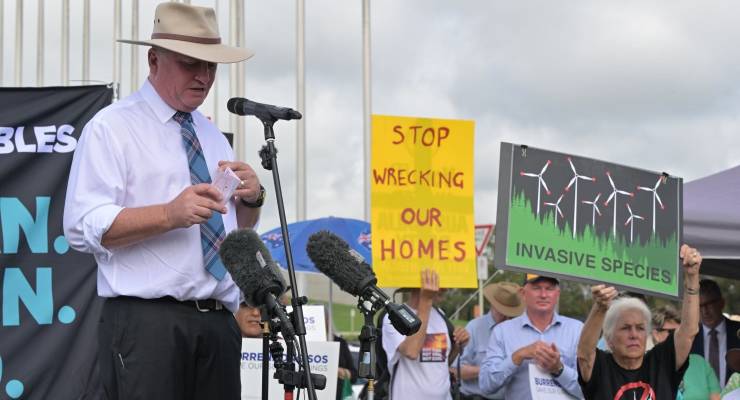
Last Tuesday, conservative MPs joined a rally against “reckless renewables” on the lawns outside Parliament House in Canberra. Barnaby Joyce, Pauline Hanson and United Australia Senator Ralph Babet addressed the crowd, claiming regional areas are being overrun by renewables projects that are degrading residents’ livelihoods, especially farmers.
Nationals leader David Littleproud responded with an effective endorsement, declaring “the bush is full”. Renewables development in regional Australia must cease, he said, suggesting Australia either rely solely on rooftop solar in metropolitan areas or downgrade its commitment to the Paris Agreement.
His Coalition partners are singing a similar tune. Opposition Leader Peter Dutton and his Liberal colleagues have been fomenting discontent around a proposed offshore wind farm in New South Wales’ Hunter and Illawarra regions.
Such resistance to nearby renewables infrastructure — let’s call it “energy NIMBYism” — is surprisingly widespread in the bush. A recent review by the Australian Energy Infrastructure Commissioner found that 92% of respondents were dissatisfied with the level of “community engagement” by renewables developers.
Do they have a point? And is it unreasonable, as Chris Kenny has argued in The Australian, for city-dwellers to expect country folk to house their power sources?
Regional renewables are unobtrusive but necessary
In short, no.
Firstly, the bush is by no means “full”, nor will it be. Wind and solar farms won’t take up nearly as much room as critics suggest, and certainly not “prime agricultural land” as they claim. NSW’s agriculture commissioner estimates the total area to be converted to renewable energy will be approximately 0.1% of the state’s rural land. Nationwide, the Clean Energy Council says if we replaced Australia’s coal plants with solar farms, we’d impact about 0.03% of the nation’s agricultural land, or around 0.02% of our total land area.
Secondly, to be most effective and reliable, renewables need to be spread out. Recent research on onshore wind from Monash University highlights the need for a diverse, interlinked grid, so areas where winds might be temporarily calm are compensated by windier areas.
Solar panels on urban roofs should certainly multiply — and nominally progressive city councils that obstruct the uptake of rooftop solar in their backyards with planning red tape are certainly hypocritical. But that won’t let the regions off the hook, especially considering regional areas contribute more greenhouse gas per capita than metro areas. Aesthetic objections — or, as a pamphlet on the Hunter and Illawarra admitted, concern about the impact on local property values — cannot trump the secure design of our energy grid.
Dutton: Bird conservationist?
But it’s not just rural conservatives who sometimes disrupt the rollout of renewable infrastructure. Many environmentalists who otherwise profess support for renewables take issue with the placement of particular projects and their environmental impact.
Some of their concerns are hopelessly misguided. For instance, some claim that decommissioned wind turbines “aren’t green” because they will end up in landfill. But according to the Clean Energy Council, approximately 85-94% of a wind turbine is recyclable.
Other conservationist impulses are derailed by misinformation. For instance, in the Hunter and Illawarra, myths have spread about wind turbines killing whales. Other environmental concerns appear purely cynical, such as Peter Dutton’s newfound concern for “rare bird species” and the “seabed” off the NSW coast.
But there are genuine trade-offs with certain renewable projects — a strategically ideal location might also be home to a threatened species, or might require clearing precious trees and plants for access roads. Such impacts are already considered extensively in federal and state approval processes. The protection of wetlands, for instance, has already seen a Victorian government-backed offshore wind farm at Port of Hastings recently rejected at the federal level — at least until changes are made.
Renewables need to go somewhere
But we should avoid making such approval processes more cumbersome, as Dutton and co are urging. Indeed, while maintaining legitimate safeguards and adding climate as a key consideration, the Albanese government should seek to make renewables approvals as seamless as possible when it introduces new laws sometime this year.
We need only look to the United States to see how systems with complex bureaucracy can be gamed by insiders to transparently anti-environmental ends. As of 2021, reviews under the US National Environmental Protection Act (NEPA) were holding up twice as many green projects as fossil fuel ones. This is why “supply-side progressives” recently successfully pushed Congress to impose page and time limits on NEPA reviews, to prevent obstructionist delays.
Veto processes that frame changes to the status quo as problems-in-waiting may prevent isolated damages in the short term. But if we fail to build enough renewables, we will only conserve a fossil fuel-based status quo that is fast unravelling and ensure much broader environmental destruction than any one project could ever cause.
To keep our emissions to safe levels, we’re going to need to build a lot of renewables. And I mean, a lot. According to Climate Change and Energy Minister Chris Bowen’s estimates, Australia must install 22,000 solar panels every day, plus 40 wind turbines per month, plus more than 10,000 kilometres of transmission lines, all within the next eight years.
These all need to go somewhere. If we pander to too much energy NIMBYism, we simply won’t build enough. We cannot privilege someone’s backyard over the whole damn earth.
Are you a regional Australian with genuine concerns about new renewables projects? Let us know your thoughts by writing to letters@crikey.com.au. Please include your full name to be considered for publication. We reserve the right to edit for length and clarity.








Here are your choices for your locality:
Pick one. I am incredulous at those who oppose (for example) solar PV farms (hundreds of quiet, clean panels sitting in a field) while expecting their power to be delivered from a polluting coal fired power station that is in someone else’s neighbourhood.
and moreover providing shelter for sheep (given farmers’ mania for chopping down any plant bigger than grass) and retaining soil moisture.
You forgot the fracking option, much favoured in QLD.
Isn’t climate change degrading residents’ livelihoods, especially farmers?
Most younger small medium farmers follow the science, but have been abandoned by the Nats in past decades in favour of big ag and fossil fueled denial and delay tactics (wedging Libs too); meanwhile culture wars and dog whistling are used to bury inconvenient facts and science in regions via RW MSM.
Yes – one of life’s mysteries is why they keep on voting for the Nats
The cult of heroic hard working ocker who triumps against all odds. Most National voters are not farmers. Regions = low SE = low education.
Which particular genius is writing the material spouted by the Coalition? I remain in awe that Morrison once warned EVs would lack the power to haul our leisure boats & ruin weekends for Australians. Their allegations are puerile & preposterous.
The reason articles like this don’t cut through with the people who matter (that is, in this case, a small percentage of farmers and other country folk) is because they try to deal rationally with what is, at heart, an irrational belief: one which the likes of Dutton and Joyce and Littlebrain recognise and build on.
Rationally, few groups stand to lose more from climate change than farmers. Rationally, nothing will ravage their land the way that climate change will. Rationally, no wind farm or attached grid will degrade land as extensively and permanently as the bloody great hole in the ground which is an open cut coal mine. And rationally, public power generation infrastructure has always been located in the country, so why single out renewable infrastructure?
Most country people recognise this. What is happening now is just the continuation of the strategy that has been followed by the fossil fuel industry and its spivs for decades. Identify a small, low-information and malleable minority and magnify their voice so that they seem like a much more significant group than they are.
High degree of cynicism about MSM in the bush, like cities, but word of mouth from a dominant character following RW MSM, to influence other low info family and friends is trustedand powerful.
Like how the shadow Minister for Veterans’ Affairs spends their time promoting climate science denial, anti-renewable talking points, fossil fuels and mining, but ignores veterans?
Veterans are all trained to kill, so it is truly remarkable how meek and mild they are, and how many of their Ministers are still walking around in good health, enjoying all their Ministerial benefits which they did little to earn.
I was amazed to learn that Bonkaby was the invisible shadow minister for vet affairs! Too busy lying on the ground and abusing dirty renewable energy
The Minister for Vet Affairs gets photo ops proportional to the number of new war memorials they produce. So it’s a good lurk for them as there’s always plenty of money for this purpose. The Canberra war museum rejig cost around half a billion, I believe. These things pop up anywhere we won, not where we lost – but who would want a photo op in Ho Chi Minh City, or Kabul? Barnaby’s latest photo op was a cracker, but he should have said he heard a car backfire, thought he was being shot at, and was taking cover. But perhaps he thought falling over while pissed was more like a real veteran.
So solar power panels and windfarms destroy agriculture. But not fracking apparently – never mind the risk of contaminating ground water.
Wait for The Voice outcomes, like Canada to remove indigenous agency to allow (carte blanche) access to native lands for mining, fracking, prospecting etc., but can also impact farmers who supported the No campaign…… short sighted….